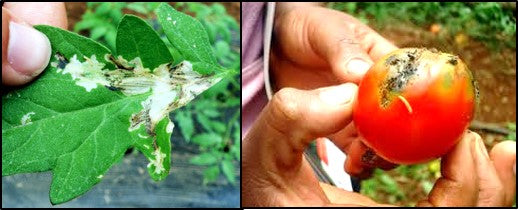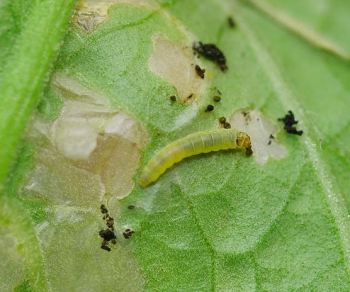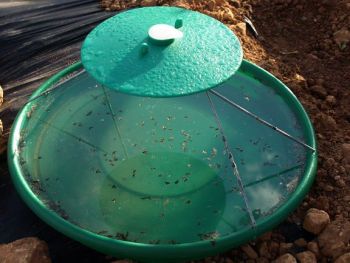Tuta Absoluta in Tomato: How to Eliminate with Home Remedies

Very good to all agrohuerters. In today’s article we are going to talk about one of the star pests in the garden. Does any name come to mind? Indeed… We are going to pay all our attention to the Tuta Absoluta, also known as the Tomato Moth.

What is the Absolute Tuta?
The Tuta Absoluta, also known as the tomato moth, is a lepidoptera of the Gelechiidae family.

It is a very common species in South America, although it does not usually appear in cold climates or above 1000 meters of altitude. In Spain it has been detected in many areas.
- The eggs are yellowish white and appear on the underside of the leaves.
- The larvae are usually cream colored with a dark head and a narrow black band on the back, this differentiates them from the potato tuber moth as their back is completely dark. In their final larval stage, their color is greenish with pink spots and they are between 1 and 8 mm long.
- And… as a good Lepidoptera, in its adult phase it is a moth with gray wings that have black spots.
Tuta Absoluta traps to detect it
These larvae usually pupate both in the leaves and in the stems or in the soil depending on the environmental conditions. When this larva pupates, it can be easily located due to the silky white cocoon that characterizes this structure. But it may already be too late for the plant, since the most serious damage occurs in the larval stage.
To locate it prematurely, water traps containing sexual pheromones can be used, the moths are attracted by the pheromones and end up trapped in the water, and other control methods that we will talk about later.

Damage of Tuta Absoluta on crops
Once the larva hatches from the egg, it looks for what is closest to hand to start feeding. It penetrates both the fruits, creating highly visible perforations, as well as the stems and leaves. On the leaves, it creates the famous white galleries by feeding only on the mesophyll, so the epidermis of the leaf remains intact, presenting that translucent white color that we observed before. These galleries subsequently become necrotic, making the presence of this plague even more evident. The affected fruits usually end up rotting, spoiling the entire harvest.
Home remedies against Tuta Absoluta
Sex pheromone traps are very useful for detecting their presence and at the same time catching potential invaders, but there are also other cheaper remedies to put an end to this plague:
1. How to get rid of tomato moth: cultural methods
As always in this matter of pests, it is necessary to maintain control over the orchard to prevent them, remove the weeds and reuse them together with the remains of the harvest, rotate crops so as not to offer free food to this species, etc. In the case of this pest, it is highly recommended to destroy the affected material. It is very hard but this prevents the plague from jumping to other species.
We can also use chromatic traps to capture it. These traps have a similar foundation to those of pheromones. In this case, the moths are attracted to a colored plate and when they come into contact with it they get stuck. They can be made at home with EVA foam and rat glue.
2. Nesidiocoris tenuis against tomato moth
- To combat the Tuta the Miridos are great, both Nesidiocoris tenuis and Macrolophus caliginosus are predatory species of the Tuta. They can be bought but also naturally attracted to your gardens by planting aromatics (I do not guarantee the success of this measure).

- We can also use Neem oil. The affected plant can be treated with this ecological insecticide. Apply with a sprayer.
- Bacillus thuringiensis: It is usually marketed in powder form, the product is diluted in water depending on the pest to be treated, in the case of Tuta it is recommended to apply it to the leaves from bottom to top every 15 days. The treatment with this bacterium is ecological and very effective. Once it is applied to the affected plant, the larvae will ingest tissues that present this bacterium. When the bacterium sporulates, it forms protein crystals-endotoxins, which have an insecticidal action. The spores are activated in the digestive system of the pest paralyzing its ability to feed and proving its death by starvation.
I leave you here a very interesting video so that you can see how the biological control insects attack the Tuta Absoluta.
References
- Arnó, J., Sheep, M., Gabarra, R. (2018). Selection of flowering plants to enhance the biological control of Tuta Absoluta using parasitoids. Biological Control,122, 41-50.
- Silva, W., Berger, M., Bass, C., Balbino, V., Amaral, M., Campos, M., Siqueira, H. (2015). Status of pyrethroid resistance and mechanisms in Brazilian populations of Tuta Absoluta. Pesticide Biochemistry and Physiology,122, 8-14.
- Bawin, T., Collard, F., Backer, L., Yarou, B., Compère, P., Francis, F., Verheggen, F. (2016). Structure and distribution of the sensilla on the antennae of Tuta Absoluta (Lepidoptera: Gelechiidae), Micron. 96.16-28.
How always I hope that the article has served you and that you never get this voracious plague.
I leave you this article to combat the white fly, another plague that can affect the tomato.
All the best

![Photo of Types of Substrates: [Concept, Characteristics, Natural and Artificial]](https://www.complete-gardening.com/wp-content/uploads/2022/08/types-of-substrates-concept-characteristics-natural-and-artificial-390x220.jpg)
![Photo of High Mountain Climate: [Characteristics, Flora, Fauna and Adaptability]](https://www.complete-gardening.com/wp-content/uploads/2022/08/high-mountain-climate-characteristics-flora-fauna-and-adaptability-390x220.jpg)

![Photo of The Croton: [Sowing, Care, Substrate, Irrigation] – Complete Guide](https://www.complete-gardening.com/wp-content/uploads/2021/06/croton_1585287769-390x220.jpg)